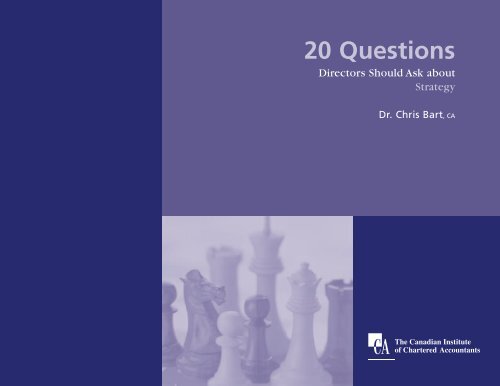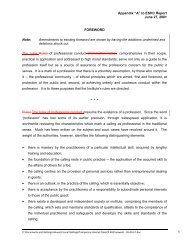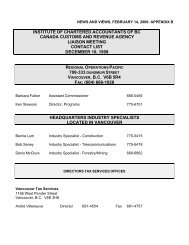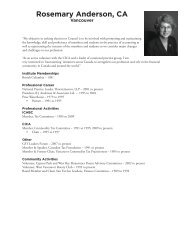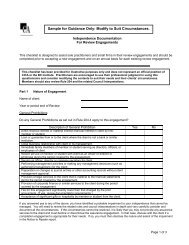CICA 20 QUESTIONS Strategy - Institute of Chartered Accountants ...
CICA 20 QUESTIONS Strategy - Institute of Chartered Accountants ...
CICA 20 QUESTIONS Strategy - Institute of Chartered Accountants ...
- No tags were found...
Create successful ePaper yourself
Turn your PDF publications into a flip-book with our unique Google optimized e-Paper software.
<strong>20</strong> QuestionsDirectors Should Ask about<strong>Strategy</strong>Dr. Chris Bart, CA
How to use this publicationEach "<strong>20</strong> Questions" publication is designed to be a concise, easy-to-read introduction to an issue <strong>of</strong> importance to directors.The questionformat reflects the oversight role <strong>of</strong> directors which includes asking management – and themselves – tough questions.The questions are not intended to be a precise checklist, but rather a way to provide insight and stimulate discussion on important topics.In some cases, Boards will not want to ask the questions directly but they may wish to ask management to prepare briefings that address thepoints raised by the questions.The comments that accompany the questions provide directors with a basis for critically assessing the answers they get and digging deeperif necessary.The comments summarize current thinking on the issues and the practices <strong>of</strong> leading organizations.They may not be the bestanswer for every organization.Thus, although the questions apply to any organization, the answers will vary according to the size, complexity and sophistication <strong>of</strong>each individual organization.AuthorDr. Chris Bart, CAPr<strong>of</strong>essor <strong>of</strong> Business <strong>Strategy</strong>DeGroote School <strong>of</strong> BusinessMcMaster UniversityProject direction byGigi DawePrincipal, Risk Management and Governance, <strong>CICA</strong>
<strong>20</strong> QuestionsDirectors Should Ask about<strong>Strategy</strong>
NATIONAL LIBRARY OF CANADA CATALOGUING IN PUBLICATIONBart, Christopher Kenneth<strong>20</strong> questions directors should ask about strategy / Chris Bart.ISBN 1-55385-031-91. Strategic planning. 2. Business planning. I. Canadian <strong>Institute</strong> <strong>of</strong> <strong>Chartered</strong> <strong>Accountants</strong>. II.Title.III.Title:Twenty questions directors should ask about strategy.HD30.28.B38 <strong>20</strong>03 658.4'012 C<strong>20</strong>03-900421-XCOPYRIGHT © <strong>20</strong>03Canadian <strong>Institute</strong> <strong>of</strong> <strong>Chartered</strong> <strong>Accountants</strong>277 Wellington Street WestToronto, ONM5V 3H2Disponible en françaisPrinted in Canada
PrefaceThe Risk Management and Governance Board <strong>of</strong> the Canadian <strong>Institute</strong><strong>of</strong> <strong>Chartered</strong> <strong>Accountants</strong> (<strong>CICA</strong>) has developed this briefing to helpmembers <strong>of</strong> Boards fulfill their responsibility for contributing to thedevelopment <strong>of</strong> their organization’s strategic direction and forapproving and monitoring the strategic plan. It is intended primarilyto help individual directors but Boards may also wish to use it fororientation and discussion.The oversight role <strong>of</strong> a director includes asking management toughquestions to assure themselves that the strategic plan has been properlydeveloped.This briefing provides suggested questions for Boards to askthe CEO, senior management, pr<strong>of</strong>essional advisors – and itself. For eachquestion there is a brief explanatory background.This publication is one <strong>of</strong> <strong>CICA</strong>’s "<strong>20</strong> Questions" series for directors.The text includes references to other titles.The Board acknowledges and thanks the members <strong>of</strong> the DirectorsAdvisory Group for their invaluable advice, Dr. Chris Bart, CA, theauthor, and the <strong>CICA</strong> staff who provided support to the project.Frank Barr, FCAChair, Risk Management and Governance BoardRisk Management and Governance BoardFrank Barr, FCA, ChairMichel Doyon, CADr. Parveen GuptaFred Jaakson, CAColin Lipson, CAMary Jane Loustel, CAKeith RobsonDirectors Advisory GroupGiles Meikle, FCA, ChairJames BaillieRobin KorthalsPatrick O'CallaghanGuylaine Saucier, FCA<strong>CICA</strong> StaffWilliam Swirsky, FCA,Vice President, Knowledge DevelopmentCairine Wilson,Vice President, Member ServicesGregory Shields, CA, Director, Assurance Services DevelopmentVivienne Livick-Chan, FCA, Principal, Risk Management and GovernanceGigi Dawe, Principal, Risk Management and Governance
Directors and <strong>Strategy</strong>According to the November <strong>20</strong>01 "Final Report <strong>of</strong> the Joint Committeeon Corporate Governance":"The objective <strong>of</strong> good governance is to promote strong, viable andcompetitive corporations. Boards <strong>of</strong> Directors are stewards <strong>of</strong> thecorporation’s assets and their behaviour should be focused on addingvalue to those assets by working with management to build a successfulcorporation and enhance shareholder value.A committed, cohesive andeffective Board adds value, first and foremost, by selecting the right CEOfor the company. Beyond this, the Board contributes to value in anumber <strong>of</strong> ways (including)…assessing and approving the strategicdirection <strong>of</strong> the company." (p.7)(emphasis added)With these final words, the notion <strong>of</strong> the Board’s responsibility for acorporation’s strategic plan has become no longer debatable. Moreover,the Toronto Stock Exchange (TSX) has recently announced that forlisted companies (and non-corporate TSX issuers, such as trusts andlimited partnerships), it now intends to expand the role <strong>of</strong> the Boardfrom its current mandate <strong>of</strong> simply "adopting a strategic planningprocess" to include the approval <strong>of</strong> the strategic plan itself.But what do these new responsibilities entail? And how shoulddirectors exercise them?A Board’s involvement in strategy, as currently envisioned, mustcontinue to honour the well-respected tradition that directors, generally,are not elected to micro-manage the corporation, but rather foroversight, insight and foresight. In terms <strong>of</strong> their ‘oversight’ function,directors must ensure that appropriate processes and controls are inplace both to manage and monitor risks and to provide for the smooth,effective and efficient functioning <strong>of</strong> the business.“Prediction is very difficult,especially about the future.”Niels Bohr
With respect to ‘insight’, directors are there to add their experiencesand wisdom, not to second-guess management, but to supplement andenhance executive decision-making.As for ‘foresight’, the directors arethere to provide a perspective on the future that helps managementidentify those opportunities that are most worth pursing.Notwithstanding these traditional functions, the role <strong>of</strong> the Board <strong>of</strong>Directors is now changing (largely to compensate for recently identifieddeficiencies in Board corporate governance).This new role requiresdirectors to be much more active participants in the ‘high-level’ affairs<strong>of</strong> the organization. It requires them especially to be "constructivelyinvolved" in the development and approval <strong>of</strong> the organization’sstrategy. One way for this constructive involvement to beoperationalized is presented in Appendix 1.These new divisions <strong>of</strong>responsibility require a corporate culture and climate <strong>of</strong> mutualrespect and trust between the Board and senior management.The participation <strong>of</strong> directors in strategy must be seen ascooperative rather than adversarial.At the core <strong>of</strong> constructive involvement is the role that directorsperform through the questions they ask. By asking questions, directorsdetermine both the degree to which the corporation is charted on aproper course and whether it is being properly managed. But not justany questions will do. Directors need to ask the right questions ifthey are to perform their duties as engaged participants in helping thecompany find a future direction that ensures its long-term competitivesurvival. Indeed, doing so is the essence <strong>of</strong> all strategic planning effortsand the winning strategies that such planning efforts aspire to produce!While the process <strong>of</strong> developing an organization’s strategy requiresmanagements and boards to consider a wide range <strong>of</strong> stakeholders(including employees, customers and communities, etc.), whoseresponse to the strategy may be critical to the organizations’ success,Boards should always remember that their primary responsibility isto the owners (shareholders, members etc.) <strong>of</strong> the organization.“No wind favors the ship thathas no charted course.”Anon
In the Beginning….Understanding <strong>Strategy</strong>The first question that every director must ask in order to grasp thepurpose and direction <strong>of</strong> the company is:1. How is strategy defined at this organization?While this question is easy to ask, it is <strong>of</strong>ten made difficult by the factthat various and numerous ‘definitions <strong>of</strong> strategy’ abound.As a result,directors <strong>of</strong>ten come to organizations with different and competingversions <strong>of</strong> the term.When combined with management’s owndefinitions, there is <strong>of</strong>ten much confusion and conflict as to whatconstitutes the proper description <strong>of</strong> an organization’s strategy.“ Trying to predict thefuture is like trying to drive down a country roadat night with no lights while lookingout the back window.Peter Drucker”Rather than present and debate alternative definitions, this documentpresents one recent and contemporary description <strong>of</strong> strategy whichappears to strike the balance that many directors seem to be lookingfor. It states that formulating and articulating a ‘strategy’ involves:(1) the determination <strong>of</strong> those long term goals (i.e., mission, vision andvalues) and objectives which reflect an organization's sources<strong>of</strong> competitive advantage and which address important stakeholderneeds; and (2) the identification <strong>of</strong> scope (or domain) <strong>of</strong> businessactivities within which those goals and objectives are to be achieved.(source: "Lasting inspiration", CAMagazine, May, <strong>20</strong>00, pp. 49-50)While other definitions exist, this latter approach to strategy is one thatis easily understood by any Board member or senior <strong>of</strong>ficer. It answersthe essential questions <strong>of</strong> strategy with which every Board membershould be concerned:2. What are we ultimately trying to accomplish and where dowe eventually want to get to? The Vision Goal3. What is our purpose – or, why do we exist?The Mission Goalsa. Who are the ‘key stakeholders’ that have a significant impacton our business and its long-term survival (i.e. customers,employees, shareholders, society, suppliers, regulators etc.)?b. What specific needs do we try to satisfy better than ourcompetitors for these ‘key stakeholders’ in order to securetheir long-term loyalty, commitment and support?4. What are the internal ethical and cultural priorities thatattract stakeholders to us? The Values Goals5. What are the specific measures and targets that we will useto judge our progress in achieving our macro-level vision,mission and values goals? The Objectives6. In what specific business arenas have we chosen to operatefor the purposes <strong>of</strong> achieving our objectives?Product/Market Scope & Domain selectionsa. Who and where are our customers?b. What products and/or services do we provide to them?1
These detailed questions (i.e. 2-6) specify the salient components thatdefine an organization’s complete strategy. As such, Boards need toconsider them as a group when seeking to describe the strategy fortheir particular organization.Interestingly, questions 2-6 are sometimes summarized in the moregeneral query <strong>of</strong> "what business are we in?" But, experience todaysuggests that using such an approach is now perhaps much too vagueto gain the sort <strong>of</strong> insights that directors are looking for. Nevertheless,whatever approach is taken, it is vital that there be agreement bothamong the directors - and between the Board and management –concerning how they choose to define and articulate theirorganization’s strategy. This is required in order to establish clearlywhich decisions are strategic versus those that are not.In fact, failure to do so will most likely result in poor communication,confusion and even conflict whenever the topic <strong>of</strong> the organization’sstrategy is raised.Thus, one important contextual question that everydirector must ask early on with respect to assessing and approving theorganization’s strategy is:7. Is the definition <strong>of</strong> strategy in this organization shared byall directors and management?The definition <strong>of</strong> strategy provided above is very robust and covers avariety <strong>of</strong> circumstances. It can be used to describe the organization’sstrategy that is currently in place - or one that is being proposed for thefuture. It can also be used to describe two terms which are <strong>of</strong>ten usedinterchangeably but which sometimes have quite different meanings:‘business strategy’ and ‘corporate strategy’. Generally speaking, thedistinction between these two concepts turns largely on the breadth<strong>of</strong> a company’s scope or domain <strong>of</strong> operations.More specifically, the definition <strong>of</strong> what constitutes "a business" istypically regarded as a specific product or service <strong>of</strong>fered to aspecific type <strong>of</strong> customer in a specific location.“ If you don’t know whereyou are going, you’ll probably wind upsomeplace else.Anon”Consequently, when the scope or domain <strong>of</strong> a company’s operationsis relatively narrow, there is virtually no difference between theorganization’s business and corporate strategies.They are synonymous.Directors <strong>of</strong> large diversified companies, therefore, need to ask:8. What are the major business strategies making up theoverall corporate strategy?As a company diversifies (i.e., adds additional major products, servicesand/or types <strong>of</strong> customers), there may be multiple business strategiesat play (each defined using the strategic components provided inquestions 2 though 6), which collectively represent an ‘overall strategy’different from the individual business pieces. It is at this point that thecorporate strategy (i.e. the collective strategy) becomes somethingseparate and distinct from the individual business strategies.In these latter circumstances, the Board should focus its attentionprimarily on the corporate strategy.The Board should only becomeinvolved with assessing and approving business strategies when theyrepresent major changes to the overall corporate direction – such as,when a new business is added/acquired or an existing businessclosed/sold. Nevertheless, it is still advisable that directors be informed<strong>of</strong> and review the major business strategies <strong>of</strong> the corporation on anongoing basis so as to better understand their impact on the wholeorganization.2
9. Do circumstances warrant the Board’s involvement in(i.e. review, assessment and approval <strong>of</strong>) the organization’soperating plan?One area that most Boards should work diligently to avoid is the review,assessment and approval <strong>of</strong> the organization’s "operating plan".Thisdoes not mean to say that directors should refrain from specifyingcertain guidelines (such as hurdle rates, threshold levels and/or policylimits), which will shape and affect the development <strong>of</strong> the operatingplan. Indeed, they should provide such guidance where appropriate.The development and content <strong>of</strong> an operating plan, however, involvesa multitude <strong>of</strong> specific details and action plans (typically referred to as‘tactics’) concerning how the organization intends to actually achieveits mission, vision, values and objectives (given its choice <strong>of</strong> businessarenas) based on the contributions <strong>of</strong> various staff members andindividual departments .Consequently, the main reason why Boards generally should not getinvolved with operating plans is fairly straightforward: this is whatmanagement is hired and paid to do. Moreover, an organization’soperating plan usually requires the involvement <strong>of</strong> many functionalexperts and innumerable decisions, which typically go well beyond theknowledge, competence and ‘time availability’ <strong>of</strong> most directors.And so,the responsibility for an organization’s operating plan is typically seenas an activity falling outside the normal governance responsibilities <strong>of</strong>the Board and its directors.The three exceptions to this general rule are: (a) when an organizationis faced with a crisis and requires whatever benefit the Board’scollective wisdom has to <strong>of</strong>fer; (b) when very small companies areinvolved (and the Board has been recruited specifically to advise at theoperational level); or (c) when there is agreement with seniormanagement concerning the Board’s involvement in this area.“ We always plantoo much and alwaysthink too little. ”Joseph Schumpeter“ It is never too lateto become what youmight have been. ”George EliotIt gives ‘flesh and bones’ to the overall (i.e. corporate or business)strategy and typically addresses all <strong>of</strong> the major functional areas such asmarketing, sales, manufacturing, engineering, R&D, finance and humanresources.Assessing and Evaluating <strong>Strategy</strong>Once the hurdle <strong>of</strong> describing and understanding an organization’sstrategy has been navigated, the Board and its directors are faced withtheir most important question:3
10. Does this organization have the right strategy and, if not,what should it be?While every organization has a strategy (which may be either explicitor implicit), not every organization necessarily has a good one. Giventhe Board’s responsibility for reviewing, assessing and approving theorganization’s strategy, it is incumbent upon them to do their utmostin trying to make the correct decision.“ To conquer the enemy without resortingto war is the most desirable. The highestform <strong>of</strong> generalship is to conquer theenemy by strategy. ”Ancient Chinese WarlordAs a first step in assessing an organization’s strategy, it is imperative thatit be formally written down and communicated explicitly to all Boardmembers to give them an adequate opportunity to reflect upon andponder the choice <strong>of</strong> goals, objectives or product/market scopeimbedded within it.using a formal strategic planning process produce better strategies andachieve higher performance results, on average, than those that do not.So what is strategic planning?Simply put, strategic planning is the process, which helps establish thestrategy <strong>of</strong> the organization. It results in a formal, written documentwhich is referred to as the strategic plan.A good strategic plan sets forththe basis upon which the mission, vision, values, and objectives <strong>of</strong> theorganization were set and establishes why the organization’s business"arenas" (i.e., product/market scope and domain) represent the optimalchoices for achieving those targets. It specifies the environmental andresource assumptions underlying the strategic choices made and themajor risks associated with those choices. Finally, a finely tunedstrategic plan lays out the rationale for all the major organizationalarrangements (i.e., structure, staff, reward and controls) and the changesnecessary to implement the company’s overall direction.“ It's not the plan that isimportant, it's the planning. ”Dr. Graeme Edwards11. What was the process followed at this organization t<strong>of</strong>ormulate the strategy contained in the strategic planand does the plan’s document contain all <strong>of</strong> theproper information?One <strong>of</strong> the initial ways in which Board members can determinethe quality <strong>of</strong> the organization’s strategy is knowing whether it wasdeveloped through a systematic and rigorous assessment process ormore through ‘gut feel and on the back <strong>of</strong> some envelope’. Researchhas confirmed that those organizations which develop their strategiesWhile there are many different approaches and procedures that anorganization can deploy as part <strong>of</strong> its strategic planning process,Appendix 2 provides a comprehensive list <strong>of</strong> the kinds <strong>of</strong> informationthat a good strategic planning process should produce.In assessing the quality <strong>of</strong> the strategy presented to them (and theplanning process by which it was developed) directors should lookespecially to the following questions and see if they are sufficientlyanswered in the plan documentation.4
12. Does the strategy have the right vision?As a general rule, visions are concerned with achieving organizationalgreatness on one or more dimensions – be it, market share, quality,revenues/pr<strong>of</strong>its or admiration, to name just a few.Visions helpprovide long-term direction to an organization and enhancestakeholders’ understanding <strong>of</strong> what the organization is ultimatelytrying to accomplish. One <strong>of</strong> the most famous vision statements evercreated was that <strong>of</strong> General Electric under the former leadership <strong>of</strong>CEO Jack Welch.The company’s vision was:To become the mostcompetitive enterprise in the world by being number one or numbertwo in every business in which we compete.“ Perception is strong and sight weak.In strategy it is important to see distant thingsas if they were close and to take a distancedview <strong>of</strong> close things. ”Miyamoto MusashiIn making an assessment <strong>of</strong> their organization’s vision it is importantfor directors to bear in mind that ‘great’ visions are <strong>of</strong>ten highly"aspirational" statements in which the ability - or way - to achieve itis neither readily apparent nor available.This is because the essentialpurpose <strong>of</strong> an organization’s vision is to describe a future state that isso desirable that it harnesses both the intellectual and emotionalcommitment <strong>of</strong> major stakeholders and makes them want to worktowards it.Unfortunately, great visions also generally take a long time to realize.So, it is important for directors to ensure that the vision involves asuitable time frame for its achievement. Indeed, it is not unusual fora vision to take anywhere from 5 to 10 years to realize.Finally, visions, which are explicit, clear and widely shared, have apowerful and positive impact on internal stakeholder (i.e. employee)behaviors.The more that individuals throughout an organization arecommitted to their vision’s achievement, the more that this ‘collectivespirit’ serves to reinforce desired behaviors and focus both individualand group efforts on desired outcomes. Consequently, it is vital fordirectors to assure themselves that their organization’s vision is widelyknown, understood - and accepted - throughout the enterprise.13. Does the strategy have the right mission?A mission statement is a formal written document that is intendedto capture and describe an organization’s unique and enduring purposeand practices. It should especially answer the most fundamentalquestion <strong>of</strong> organizational purpose:Why do we exist?Generally speaking, every organization exists because it is able to meetand satisfy the needs <strong>of</strong> multiple stakeholders: shareholders, customers,employees, suppliers and society-at-large.The more an organization isable to meet and satisfy those needs better than its competitors, thegreater the probability that the organization will succeed and win overthe long term. Good missions, therefore, seek to attract and retain theloyalty and commitment <strong>of</strong> various stakeholders by respondingsimultaneously to their competing needs.On the other hand, to the extent that an organization fails to satisfy aparticular stakeholder group in a significant way, it risks alienating theloyalty and commitment <strong>of</strong> that group to the organization and, evenworse, goading them into an attack.This can lead, under extremeconditions, to problems in organizational survival.Thus, it is the responsibility <strong>of</strong> directors to ensure that theirorganization’s mission statement acknowledges the importance <strong>of</strong>multiple stakeholder groups to the organization’s long term survivaland to balance their competing interests. But, it is especially importantthatthe specification <strong>of</strong> stakeholder needs contained in the mission be5
grounded in reality. Directors, therefore, need to ensure that thestrategic plan indicates the basis upon which the needs <strong>of</strong> eachstakeholder group were identified and selected (e.g.customer/employee surveys; comparative competitive positioning;benchmarking studies, etc.)Finally (as with the case <strong>of</strong> the organization’s vision), missionstatements, which are explicit, clear and widely shared have beenshown to have a powerful and positive impact on internal stakeholder(employee) behavior.Accordingly, directors need to that awareness,understanding and acceptance <strong>of</strong> the mission exists throughout theorganization.14. Does the strategy have a proper statement <strong>of</strong> values?For an organization, it is important that the actions and behaviors <strong>of</strong>its employees – in striving to maximize shareholder value and achieveperformance targets - can withstand the test <strong>of</strong> public scrutiny.Valuesconstitute the internal ethical and cultural priorities (e.g., honesty,mutual respect, transparency, innovation, teamwork, etc.) that shape theway in which people behave and make decisions.When widely shared,they enhance especially an organization’s ability to focus employeebehavior. Directors, therefore, need to make sure that theirorganization’s strategy contains a statement <strong>of</strong> values which theyconsider important for the harmonious and ethical running <strong>of</strong> theiroperations. Organizations can then use their ‘statements <strong>of</strong> values’and ‘codes <strong>of</strong> conduct’ as vehicles for attracting the right stakeholdersto them.One notable example <strong>of</strong> an aspirational vision occurred in the early 1960s when USPresident John Kennedy challenged NASA to: (sic) ‘land a man on the surface <strong>of</strong> the moonand return him safely back to earth before the end <strong>of</strong> the decade’. Apparently, few personsin NASA actually believed that it could be done because it involved so many newtechnologies which had yet to be invented. Nevertheless, Kennedy’s vision made thescientists at the space agency excited about the prospects <strong>of</strong> actually making it happen‘during their watch’ and, <strong>of</strong> course, they eventually fulfilled it.6
15. Does the strategy contain objectives which are wellformulated and well stated?An organization uses objectives to measure and judge its progressin achieving its mission, vision and values goals.As a general rule,objectives should be established for each <strong>of</strong> the goals contained withinthe mission, vision and values. It is also critical that an organizationhas objectives which are both well formulated and well stated.Toaccomplish this, directors need to make sure that their organization’sobjectives are:• specific (to avoid ambiguity as to what is the organization istrying to accomplish);• measurable (to allow for the determination <strong>of</strong> the objectives’achievement or not);• acceptable (to ensure that the method for measuring progressagainst the mission, vision and values is perceived as fair); and• timely (as the great economist, Lord Keynes, once said: "In thelong run, we are all dead!")Organizational surveys asking if macro-level objectives are understoodand accepted by employees at each level are also useful for determiningthe reasonableness <strong>of</strong> objectives.Lastly, when employees feel connected to the organization’s strategicobjectives, they work more diligently towards their achievement. It is,therefore, essential for directors to assure themselves that those macroorganizational objectives (which have been designed to measure anorganization’s progress in implementing its mission, vision and values)have been translated, disseminated and aligned throughout theorganization – especially to the front line.“ If you have boarded thewrong train, it is <strong>of</strong> no userunning along the corridor inthe opposite direction. ”Regarding this last point, detailed organizational objectives are beststated for a time period <strong>of</strong> one to three years and revised at the end<strong>of</strong> each year as new information becomes available.A key consideration in setting objectives is the degree to which thespecific achievement targets contained in the objectives are perceivedas realistic by those responsible for their achievement.To determinethis, directors need to know the basis upon which the objectives wereestablished (e.g. customer/employee surveys; comparative competitivepositioning; benchmarking studies etc.) and whether the objectivesbalance the conditions in the external environment (especially theperformance <strong>of</strong> competitors) with the organization’s internalcapabilities (See also Question 16). Only when armed with thisinformation can directors judge for themselves whether the objectivesstated are realistic or not, and possibly in need <strong>of</strong> adjustment.Anon16. Are the business arenas specified in the organization’sstrategy the right ones?An organization should strive to identify and focus its resources onthose business arenas (existing or new) where (a) the potential marketopportunity exists for the enterprise to achieve its stated goals andobjectives AND (b) the organization has the internal resources – eitheron hand or quickly available - to pursue and capture the opportunity.When either (or both) <strong>of</strong> these conditions does not exist, anorganization is faced with the difficult challenge <strong>of</strong> determining if andhow the situation might be turned around and made more favorable -or whether to seek ‘greener pastures’.7
Making such business arena choices is generally regarded as one <strong>of</strong> themost demanding activities in the process <strong>of</strong> formulating or evaluatingan organization’s strategy. It involves the most amount <strong>of</strong> informationgathering and typically represents the bulk <strong>of</strong> the organization’sstrategic planning efforts.Accordingly, in making their assessment <strong>of</strong> the market potential andinternal capabilities associated with various business arenas, directorsneed to have in place a strategic planning process, which ensuresthat the following questions are adequately addressed for eachbusiness arena:• What is the nature and extent <strong>of</strong> demand for the products andservices <strong>of</strong>fered?• What is the potential for pr<strong>of</strong>it?• To what extent (and in what way) are customer needs currentlybeing met by existing competitors?• To what extent are the organization’s products and servicessignificantly differentiated from - and <strong>of</strong>fer a clear advantage over- existing competitors?• Does the organization have the resources, skills and capabilitiesrequired to pursue the growth and pr<strong>of</strong>it potential in thebusiness arenas that it has targeted?• If lacking a competitive advantage or any specific resources, skillsor capabilities, how does the organization intend to acquire them– if at all?• What are the major ‘assumptions’ underlying the choice <strong>of</strong> eachmajor business arena?• What are the methods <strong>of</strong> entry to or exit from the major businessarenas selected (i.e. merger, acquisition, divestment, closure, sale,etc.)• What alternative business ‘postures’ (i.e., grow/invest, hold,harvest, divest, no entry) were considered and rejected for eachbusiness arena (both existing and new).“ Without competitors therewould be no need for strategy,for the sole purpose <strong>of</strong> strategicplanning is to enable thecompany to gain, as effectivelyas possible, a sustainableedge over its competitors. ”Kenichi Ohmae<strong>Strategy</strong> Implementation Considerations17. Have the proper organizational arrangements beenselected, designed and ‘aligned’ to reflect, reinforce andsupport the strategy?Given sufficient time, information and human intelligence, anyorganization is capable <strong>of</strong> designing outstanding strategies.Thetough part occurs, though, when it comes to execution i.e. turning thestrategy into a reality.One <strong>of</strong> the major ways in which execution happens is through theorganization’s operating plan. But, directors are generally discouragedfrom becoming involved in this area and for good reason (See thediscussion related to Question 9).The other major method by which an organization executes its strategyis when it aligns its staff, structures, reward and control systems to8
focus on, support and reinforce the organization’s strategic goals andobjectives.This is called ‘strategic organizational alignment’ and itentails, at least, four major considerations with which directors need tobe concerned.The first involves translating the mission, vision, values and objectivesinto terms that are meaningful and understood by ALL organizationalmembers so that they can, in turn, put forward a united and concertedeffort towards the strategy’s realization. Often, this requires thatemployees’ jobs must be redefined or re-specified to take into accountthe requirements <strong>of</strong> the strategy.The second important element <strong>of</strong> ‘alignment’ requires that individualsbe either hired on the basis <strong>of</strong> their ability to perform the critical tasksand priorities specified in the strategy – or be trained to do so.A thirdelement stipulates that information systems be adjusted to regularlymeasure and report on an organization’s progress against all aspects <strong>of</strong>its strategy as well as the contributions <strong>of</strong> individual members towardsits achievement. In so doing, the effectiveness <strong>of</strong> both operating plansand specific job behaviors can be assessed and modified in order tobetter achieve the strategy - and before it’s too late. Finally, the fourthelement <strong>of</strong> organizational alignment stresses that reward systems beadjusted so that employees feel inspired and motivated to put evengreater effort into making the strategy happen.When these organizational alignment modifications have been made,the probability <strong>of</strong> an organization achieving its strategic goals andobjectives will be greatly enhanced.Assessing Strategic Risks18. Have all the significant internal and external strategic risksbeen identified, quantified and addressed in the plan?In the course <strong>of</strong> developing a strategic plan, there is always uncertaintyaround its ultimate attainment.And with uncertainty comes risk i.e.,possible events (with varying degrees <strong>of</strong> probability attached), which ifrealized, will have an adverse effect on the organization and interferewith its ability to either achieve its business opportunities or overcomeorganizational weaknesses.The presence <strong>of</strong> risks can also significantlyalter which opportunities to pursue, get in the way <strong>of</strong> certainorganizational arrangements and make the accomplishment <strong>of</strong>objectives related to the mission, vision and values extremely difficult.Consequently, it is necessary for directors to understand those risksassociated with a particular strategy, their probability or likelihood <strong>of</strong>occurrence and their potential impact on the organization.While there are many different types <strong>of</strong> risk that an organization mightpossibly face, the main strategic risk areas <strong>of</strong> concern to the Boardparallel those which drive its strategy, namely, the risk that:• stated objectives will not be realized;• the market potential perceived to exist will not materialize (e.g.due to changes in: customers’ demand/satisfaction, commodityprices, competitive intensity, regulations, government etc.);• internal resources necessary for strategic success either disappearor cannot reasonably be secured (e.g., the loss <strong>of</strong> key employees,a decline in company morale, the inability to secure apatent/technology or to innovate, failed marketing/salesinitiatives, fraud and asset theft, etc.); and• organizational arrangements chosen to implement the strategywill not function as intended (e.g. the benefits <strong>of</strong> moving to morecentralization/decentralization do not materialize).9
These risks should be spelled out in the strategic plan.And, directorsshould approve only those strategies where the associated risks - andtheir impact - are deemed to be tolerable given the potential for return.The Board should also be assured that the organization has put in placea risk management system for measuring and monitoring known risks,estimating their impact, mitigating their occurrence or effect (e.g.,through insurance, hedging, codes <strong>of</strong> conduct or assigned riskmanagers), and identifying emerging dangers.A more comprehensive discussion <strong>of</strong> current risk managementpractices is contained in a companion publication <strong>of</strong> the <strong>CICA</strong> called<strong>20</strong> Questions Directors Should Ask About Risk. Directors shouldfamiliarize themselves with these questions as well.Monitoring Progress19. Are appropriate mechanisms in place to provide theBoard with timely feedback on the organization’s progressagainst its strategy, the underlying causes <strong>of</strong> anyperformance variance and any changes in theinternal/external environments or risk factors whichwould cause the Board to consider altering theorganization’s strategy?In fulfilling their strategic and governance responsibilities, it isincumbent upon directors to monitor the organization’s progressagainst its strategic objectives and related risk factors. Consequently,directors need to ensure that their organization’s progress against each<strong>of</strong> its strategic objectives (along with an update on any significantbusiness risks) be reviewed at each meeting <strong>of</strong> the full Board.A Word About ‘Constructive Involvement’and Who Does WhatAccording to the OECD:"Corporate governance is the system by which business corporationsare directed and controlled.The corporate governance structurespecifies the distribution <strong>of</strong> rights and responsibilities among differentparticipants in the corporation, such as, the Board, managers,shareholders and other stakeholders, and spells out the rules andprocedures for making decisions on corporate affairs." April 1999.Today, the responsibility to actively participate in the development andapproval <strong>of</strong> the overall strategy, to monitor the strategy’s progress, andto oversee and guide the organisation represents some <strong>of</strong> thequintessential activities <strong>of</strong> corporate governance.And that responsibility,today, is seen to reside principally with the Board.As Boards take on their new tasks and duties in this area, there is goingto be a shift in both the role and manner in which they interact withmanagement – especially the CEO. Unfortunately, many seniorexecutives will see the Board’s new strategic responsibilities asincursions into decision areas that were once strictly within the domain<strong>of</strong> the executive suite. But, times have changed.And astute Boards willrecognize – and anticipate - the potential resistance that they mayencounter from senior managers as they attempt to become moreinvolved participants in their organization’s strategic decision making.Indeed, they have no choice. Boards must now participate in, assess andapprove the strategy. (Appendix 1 lays out one framework in which theresponsibilities for the organization’s strategy and strategic planning aredivided between the Board and Senior Management.) But, it is in noone’s best interests if the relationship between the Board and seniormanagement is adversarial – especially when it comes to plotting theorganization’s future direction.10
Boards, therefore, should seek to avoid creating such a situation.And tocircumvent it, directors need to ask:<strong>20</strong>. Are the Board and its directors constructively involved inthe organization’s strategy?To achieve a state <strong>of</strong> constructive involvement, one <strong>of</strong> the first stepsthat the Board needs to take is to openly and candidly discuss with theCEO (and other members <strong>of</strong> senior management) the new governanceresponsibilities required from the Board in terms <strong>of</strong> the organization’sstrategy. Ultimately, the Board and management must come to somenew understanding and agreement as to:• ‘who does what’ in terms <strong>of</strong> formulating, assessing and approvingthe organization’s strategy and strategic plan,• what areas constitute strategic, and therefore, Board decisions,• what areas represent operational/tactical – or management -decisions.Senior managers need to understand that the Board’s new tasks withrespect to strategy are not being taken because <strong>of</strong> some lack <strong>of</strong>confidence in the organization’s leadership. Rather, they are part <strong>of</strong> thenew stewardship role that the Board is being asked to perform in orderto avoid the two major governance mistakes <strong>of</strong> the past, namely, the‘rubber stamping’ <strong>of</strong> major management decisions (especially theorganization’s strategy) and the Board’s micro managing <strong>of</strong> theorganization’s operations.Of course, constructive involvement ultimately depends on the level <strong>of</strong>trust and mutual respect, which exists between the Board and seniormanagement. Directors need to feel comfortable in asking strategicquestions.And senior management needs to feel that it can beforthcoming in its responses to those questions. Consequently, it isrecommended that the Board conduct an annual self-assessment in thearea <strong>of</strong> ‘constructive involvement’, possibly with a skilled facilitator, tohelp directors determine the degree <strong>of</strong> trust and respect that existswith management as well as to help sort out mutual responsibilities.Tothe extent that problem areas are identified, the Board can thenconsider what steps it next needs to take to correct the situation.“There may be no single thing more important in our efforts toachieve meaningful work and fulfilling relationships than to learn andpractice the art <strong>of</strong> communication.”Max De Pree"Leadership Is an Art"11
Appendix 1. Constructive Involvement: Board and Management Roles and Responsibilitiesfor Strategic Plans and PlanningThe following table lays out one recommended framework in whichthe responsibilities for the organization’s strategy and strategic planningare divided between the Board and senior management.The precisedivision <strong>of</strong> responsibilities will depend on the size, complexity andresources <strong>of</strong> individual organizations. Each organization shoulddetermine the planning responsibilities <strong>of</strong> its Board and managementafter considering the nature <strong>of</strong> the organization, the composition <strong>of</strong> theBoard, and any specific regulatory requirements.TASKDeveloping a strategic planning processAssessing and approving the strategic planning processDeveloping the mission, vision, and values (1)Assessing and approving the mission, vision and valuesDeveloping the objectivesAssessing and approving the objectivesRESPONSIBILITYManagement BoardXXXXXXIdentifying the business arenasAssessing and approving the business arenasData collection and analysis with respect to the strategic plan(See Appendix 2)Preparing the written strategic planAssessing and approving the strategic planScheduling strategic planning and strategy review meetingsPreparing operating plansPreparing budgetsApproving budgetsPreparing reports on the organization’s strategic progressand accomplishment <strong>of</strong> strategic objectivesMonitoring the execution <strong>of</strong> the strategy and its achievementApproving changes to the strategy as warrantedXXXXXXXXXXXX(1) while traditional practice generally restricts Board involvement to the assessment andapproval <strong>of</strong> the mission, vision and values, recent research suggests that superior organizationalperformance and innovativeness occurs when Boards are more active participants in thedevelopment <strong>of</strong> these strategic documents.12
Appendix 2. Strategic Plans and PlanningA Strategic Plan is a document that records the decisions theorganization has made with respect to its future strategy.The planshould also contain the rationales, analyses and background informationsupporting those decisions.A good strategic planning process is onewhich facilitates the creation <strong>of</strong> a superior strategy and ensures thatthe appropriate information is contained in the plan.The types <strong>of</strong>information typically included in a strategic plan are:Vision, Mission and ValuesObjectives (related to the mission, vision and values)Major Business Arenas (for achieving the mission, vision, values andobjectives)External Environmental Analysis• Political, economic, technological and social demographicsanalysis• Market research related to identifying and satisfying (current &unmet) investor, customer and societal needs• Potential market demand/growth/pr<strong>of</strong>itability• Nature and degree <strong>of</strong> competition• Position <strong>of</strong> competitors and their degree <strong>of</strong> product/servicedifferentiation• Barriers to entry/exit• Switching costs related to customers and suppliers• Nature and degree <strong>of</strong> customer and supplier dependencies• Industry benchmarks and performance standardsInternal Resource Analysis• Strengths and weaknesses analysis related to achieving objectivesand increasing competitive advantage• Analysis <strong>of</strong> capabilities for innovation• Customer satisfaction survey results• Employee satisfaction survey results• Investor/analyst satisfaction results• Gap Analysis results• Key success factors• Plans for overcoming critical weaknesses or strengtheningadvantages13Methods <strong>of</strong> entry into (or exit from) major business arenas• Merger/acquisition• Joint venture• Strategic alliance• Divestment/closure/saleRisk Analysis• Major risks (internal and external)• Risk impact analysis e.g. sensitivity analysis• Risk impact outcomes - including best and worst cases• Risk management/abatement tacticsAssumptions• Qualitative• QuantitativeMajor Strategic Alternatives• A summary <strong>of</strong> major changes represented in the proposed/futurestrategy in relation to the strategy currently in use• Descriptions <strong>of</strong> major strategic alternatives that were rejected andthe rationale for their rejectionRationales for the proposed strategy – i.e. how the proposed/futurestrategy will optimize the achievement <strong>of</strong> objectives in accordance withthe mission, vision and values.Strategic Organizational Alignment/<strong>Strategy</strong> Implementation• Organization chart• Major changes in job definitions, information systems, and humanresource practices in order to bring them into alignment with thestrategy• Succession plan for key management positions• Potential areas <strong>of</strong> resistance to change and methods forovercoming them• Links between the strategic and operating plansFinancial and other measurements• The projected financial impact <strong>of</strong> the proposed/future strategy forat least 3 years• Key performance indicators• Milestones
Where to find more informationCanadian <strong>Institute</strong> <strong>of</strong> <strong>Chartered</strong> <strong>Accountants</strong> publications,The <strong>20</strong> Questions series<strong>20</strong> Questions Directors Should Ask about Executive Compensation<strong>20</strong> Questions Directors Should Ask ask about IT<strong>20</strong> Questions Directors Should Ask aboutManagement’s Discussion and Analysis<strong>20</strong> Questions Directors Should Ask about Privacy<strong>20</strong> Questions Directors Should Ask about Risk<strong>20</strong> Questions Directors Should Ask about <strong>Strategy</strong>Other Publications on governance, strategy and riskCA/CPA Performance View.Guidance on Control, 1995.Guidance for Directors: Governance Processes for Control, 1995.Guidance for Directors: Dealing with Risk in the Boardroom,April <strong>20</strong>00.Managing Risk in the New Economy, <strong>20</strong>00.Crisis Management for Directors, <strong>20</strong>01.Strategic Planning:What Boards Should Expect from CFOs, <strong>20</strong>03.Additional ReferencesBart, C.K.:“Sex, Lies and Mission Statements”, Business Horizons, Nov.-Dec. 1997,pp. 9-18“Industrial Firms and the Power <strong>of</strong> Mission”, Industrial MarketingManagement, Vol. 26, 1997, pp. 371-383.“Mission Possible”, CAMagazine, September, 1997.“Mission Matters”, CAMagazine, March, 1998, pp. 31-41.“Making Mission Statements Count”, CAMagazine, March, 1999,pp. 37-47.“Accepting the Mission”, CAMagazine, August, 1999, pp. 33-34.“Lasting Inspiration”, CAMagazine, May, <strong>20</strong>00, pp. 49-50.“Who's Running the Store?”, CAMagazine, August <strong>20</strong>01, pp. 22-27.A Tale <strong>of</strong> Two Employees, Corporate Missions Inc. Press, <strong>20</strong>02.De Gues, Arie. The Living Company: Habits for Survival in aTurbulent Business Environment, 1997.Joint Committee on Corporate Governance. Report: BeyondCompliance: Building a Governance Culture, <strong>20</strong>01Mintzberg, Henry, Ahlstrand, Bruce, and Lampel, Joseph. <strong>Strategy</strong> Safari:A Guided Tour Through the Wilds <strong>of</strong> Strategic Management, 1998.Toronto Stock Exchange, TSX Company Manual, Part IV Section M.Corporate Governance. Revised Requirements, Guidelines and PracticeNotes, November 28, <strong>20</strong>02.14
About the authorDr. Chris Bart, CADr. Chris Bart, CA is a leading expert in helping organizations develop mission andvision statements that get results. He has published over 50 articles, cases and reviewsand he has a unique expertise in helping firms organize their internal structure to betterachieve their mission.Dr. Bart is currently a Pr<strong>of</strong>essor <strong>of</strong> Business <strong>Strategy</strong> at the Michael G. DeGroote School<strong>of</strong> Business, McMaster University, Hamilton, Ontario and a principal with CorporateMissions Inc. In 1993, he helped found the Management <strong>of</strong> Innovation & New TechnologyResearch Centre (MINT-RC) at McMaster and was named its first Director. In 1994, heconceived and created the Innovation Management Network - a world-wide association <strong>of</strong>academics and practitioners who communicate and collaborate on matters <strong>of</strong> innovationand new technology management through the Internet.A highly regarded lecturer, Dr. Bart has been named both "Outstanding UndergraduateBusiness Pr<strong>of</strong>essor" (1982 and 1997) and "MBA Pr<strong>of</strong>essor <strong>of</strong> the Year" (1984, 1989 and1991). In 1995, he received McMaster's highest teaching award:The President's Awardfor Teaching Excellence.Dr. Bart is a <strong>Chartered</strong> Accountant. He is a past Director <strong>of</strong> the Planning Executives<strong>Institute</strong> and has been a member <strong>of</strong> numerous company Boards <strong>of</strong> Directors andpr<strong>of</strong>essional organizations. He is listed in Canadian WHO'S WHO,Who’s Who inCanadian Business, and the International Who’s Who <strong>of</strong> Pr<strong>of</strong>essionals.
ISBN 1-55385-031-99 781553 850311<strong>20</strong> QuestionsDirectors Should Ask about<strong>Strategy</strong>277 Wellington Street WestToronto, ON. CanadaM5V 3H2Tel: 416-<strong>20</strong>4-3280Fax: 416-<strong>20</strong>4-3340www.cica.ca


